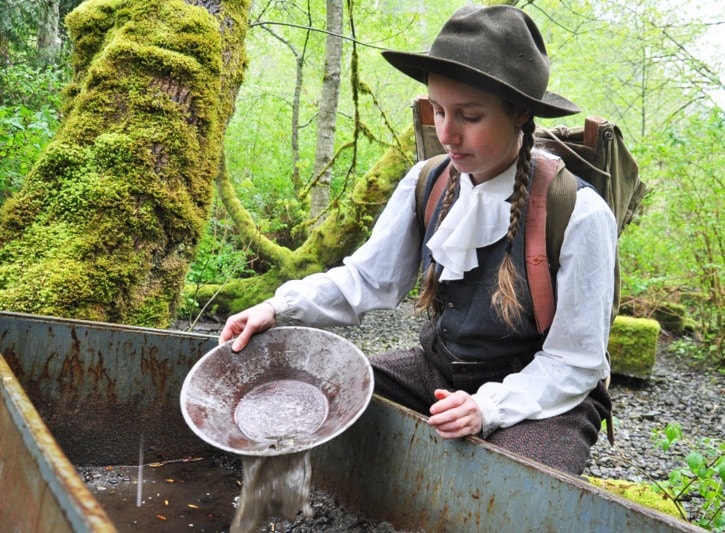In her floppy miners hat and suspenders, Penny the Prospector swirls grit and water in her pan and soon spots a sparkly little fleck. Gold? Not in Goldstream.
Naturalists at the Goldstream Nature House use period costumes and a muddy trough to give students a hands-on history lesson on the river's short-lived but energetic gold rush 150 years ago.
Kids pan for pyrite bits – fool’s gold – and learn that despite it’s name, Goldstream holds virtually no gold. Unfortunately, some adults are still trying to pan like its 1863.
Goldstream naturalists say a steady number of people are calling to inquire about panning for gold on the river. Some show up with gold panning gear in hand.
“We had five or six guys show up from Vancouver thinking since it’s called Goldstream, there’s got to be gold there,” said naturalist Tracey Bleackley. “Fortunately most people come to us first so we can stop them.”
“We’ve had a number of phone calls asking ‘where’s the best place to pan in the river?’” said naturalist Bre Robinson, who plays the role of Penny the Prospector. “Whenever the economy is down, some people try to turn to the basics.”
Disturbing the river bed and removing gravel and dirt, especially in a provincial park, is illegal without a permit and can kill incubating salmon eggs.
“If you disturb the gravel you kill the eggs,” Robinson said. “Mucking around in the river isn’t good for any species.”
The naturalists suspect the high market price of gold and TV reality shows such as Discovery Channel’s Gold Rush have spurred a renewed interest in what is known as placer mining. Goldstream is a sure hit in Google searches for modern-day panning hobbyists.
“I’d like to think we stop all (gold panners) but unfortunately I’m sure we haven’t,” Bleackley said. “There is no gold in that river, but naturalists here think of the salmon as the gold.”
The "gold" in Goldstream originates from colonial-era engineer Peter Leech, who referred to the stream as Gold Creek in 1858 after claiming he found traces of gold, according to the book Old Langford by Maureen Duffus.
It was a name that stuck as rumours grew about a major gold strike near Fort Victoria, and it offered more hope for the young colony than the original name of Dead Man’s Creek.
In the fall of 1863 some 30 companies with hundreds of men staked claims and began peppering the Goldstream area with mine shafts. A number of assays even suggested the Goldstream ore held valuble deposits of gold.
Riches didn’t materialize, and by the following summer, miners abandoned Goldstream for more promsing finds in Leechtown. To this day, placer miners still legally sluice for gold in claims on the Leech River, near Sooke.
“In October, 1863 (miners) stampeded to Goldstream; now some nine months later they headed for Leechtown,” wrote Paula Wuorinen in A History of Goldstream Provincial Park, from 1976.
”Some believe not one speck of gold was taken from Goldstream. There is no doubt that early colonists and miners believed in Goldstream.”
For more on placer mining on Vancouver Island, see vipma.ca. For more on Goldstream park, see www.goldstreampark.com.
editor@goldstreamgazette.com
